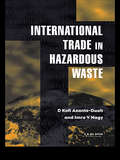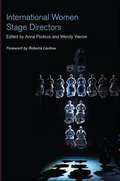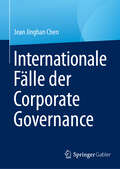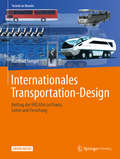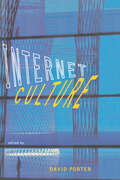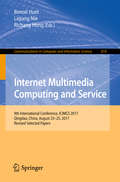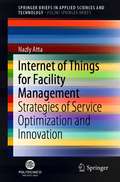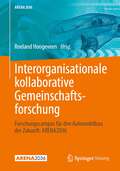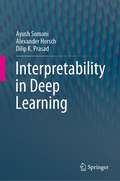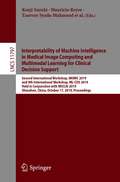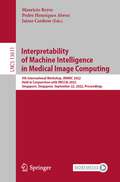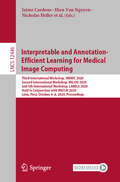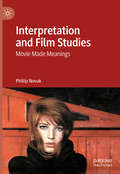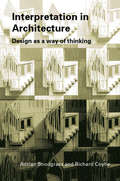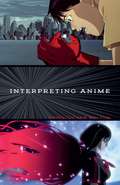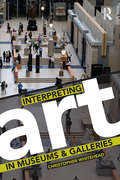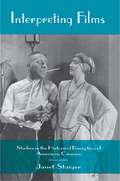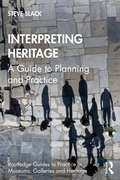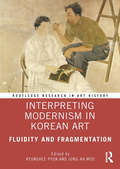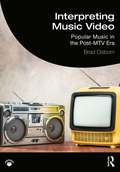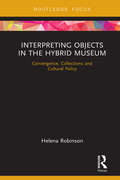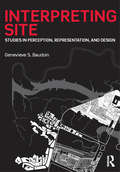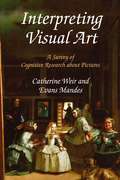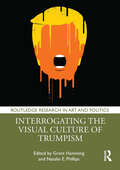- Table View
- List View
International Trade in Hazardous Wastes
by D.K. Asante-Duah I.V. NagyThis book discusses the need for a regulated and informed forum for international trade in hazardous waste. The authors argue that with careful planning, health and ecological risks can be minimized and net economic benefits realized fairly. The book examines the key parameters that should be considered by potential trading nations to ensure an opt
International Women Stage Directors
by Wendy Vierow Anne FliotsosA fascinating study of women in the arts, International Women Stage Directors is a comprehensive examination of women directors in twenty-four diverse countries. Organized by country, chapters provide historical context and emphasize how social, political, religious, and economic factors have impacted women's rise in the theatre, particularly in terms of gender equity. Contributors tell the stories of their home country's pioneering women directors and profile the most influential women directors practicing today, examining their career paths, artistry, and major achievements. Contributors are Ileana Azor, Dalia Basiouny, Kate Bredeson, Mirenka Cechová, Marié-Heleen Coetzee, May Farnsworth, Anne Fliotsos, Laura Ginters, Iris Hsin-chun Tuan, Maria Ignatieva, Adam J. Ledger, Roberta Levitow, Jiangyue Li, Lliane Loots, Diana Manole, Karin Maresh, Gordon McCall, Erin B. Mee, Ursula Neuerburg-Denzer, Claire Pamment, Magda Romanska, Avra Sidiropoulou, Margaretta Swigert-Gacheru, Alessandra Vannucci, Wendy Vierow, Vessela S. Warner, and Brenda Werth.
Internationale Fälle der Corporate Governance
by Jean Jinghan ChenDieses Buch bietet Einblicke in aktuelle Fragen der Corporate Governance, indem es zwölf Fälle aus den 2010er und 2020er Jahren untersucht, in denen die Corporate Governance als problematisch angesehen wurde. Die Fälle sollen den Leser mit Episoden aus dem "wirklichen Leben" vertraut machen, die Auswirkungen auf die Corporate Governance haben. Sie beleuchten, warum es immer wieder zu Unternehmensskandalen kommt, inwieweit diese auf ein Versagen der Corporate Governance zurückzuführen sind und auf welche Weise die Corporate Governance - und das Verhalten derjenigen, die für eine gute Governance und eine ethische Kultur in ihrem Unternehmen sorgen - in Zukunft verbessert werden kann. Dieses Buch ist für Unternehmer, Studenten der Wirtschaftswissenschaften und Juristen von Interesse und regt zur Diskussion über die Gründe an, warum die Corporate Governance versagt hat oder als unzureichend angesehen wurde.Dieses Buch stellt die Übersetzung einer englischsprachigen Originalausgabe dar. Die Übersetzung wurde mit Hilfe von künstlicher Intelligenz erstellt (maschinelle Übersetzung mit DeepL.com). Eine anschließende manuelle Überarbeitung erfolgte vor allem nach inhaltlichen Gesichtspunkten, so dass das Buch stilistisch von einer herkömmlichen Übersetzung abweicht.
Internationales Transportation-Design: Beitrag der HfG Ulm zu Praxis, Lehre und Forschung (Technik im Wandel)
by Hartmut SeegerDas Entwickeln von Fahrzeugen aller Art ist heute eine eigenständige Wissensdisziplin, die in ihrem gesamten Umfang mit digitalen Tools bearbeitet wird. Die diesbezüglichen Teilaufgaben, wie z.B. die Maßkonzeption von Fahrzeugen, entstanden aber alle in der vorausgehenden Phase in der handwerklichen Tradition sowie durch die Orientierung am sogenannten Funktionalismus und an den neuen Designwissenschaften, wie z.B. der Ergonomie. Das vorliegende Werk behandelt diese 100jährige Entwicklung am Beispiel der diesbezüglichen Pionierinstitution, der Hochschule für Gestaltung Ulm (1953-1968) und der Arbeit ihrer Alumnis bis in die Gegenwart.Die zentrale Information dieses Werkes betrifft diese interessante Wechselwirkung und Entwicklungslinie vom Kinderwagen bis zur Weltraumstation und von den Zeichentechniken bis zur designbezogenen Semantik und interfaceorientierten Pragmatik.
Internet Culture
by David PorterThe internet has recently grown from a fringe cultural phenomenon to a significant site of cultural production and transformation. Internet Culture maps this new domain of language, politics and identity, locating it within the histories of communication and the public sphere. Internet Culture offers a critical interrogation of the sustaining myths of the virtual world and of the implications of the current mass migration onto the electronic frontier. Among the topics discussed in Internet Culture are the virtual spaces and places created by the citizens of the Net and their claims to the hotly contested notion of "virtual community"; the virtual bodies that occupy such spaces; and the desires that animate these bodies. The contributors also examine the communication medium behind theworlds of the Net, analyzing the rhetorical conventions governing online discussion, literary antecedents,and potential pedagogical applications.
Internet Multimedia Computing and Service: 9th International Conference, Icimcs 2017, Qingdao, China, August 23-25, 2017, Revised Selected Papers (Communications In Computer And Information Science #819)
by Benoit Huet Richang Hong Liqiang NieThis book constitutes the refereed proceedings of the 9th International Conference on Internet Multimedia Computing and Service, ICIMCS 2017, held in Qingdao, China, in August 2017. The 20 revised full papers and 28 revised short papers presented were carefully reviewed and selected from 103 submissions. The papers are organized in topical sections on multimedia information fusion, image processing and object recognition, machine learning and representation learning, multimedia retrieval, poster papers.
Internet of Things for Facility Management: Strategies of Service Optimization and Innovation (SpringerBriefs in Applied Sciences and Technology)
by Nazly AttaThis book proposes strategies for FM services optimization and innovation, based on innovative models of IoT application and big data management within FM processes, able to support FM stakeholders in: orienting and managing big data flows and their sources (sensor, RFID, etc.); changing FM services demand/offer and developing new approaches to FM agreements; drawing new supply chains based on network approaches; and outlining new profiles of competences for FM stakeholders. The book demonstrates that FM stakeholders (e.g. Real Estate owners, FM providers, service suppliers, etc.) increasingly need new support tools for understanding the features of the current offer of innovative ICT solutions in order to become promoters of FM innovation, and it provides them with an analytical-procedural framework useful for defining and implementing IoT-based FM services.
Interorganisationale kollaborative Gemeinschaftsforschung: Forschungscampus für den Automobilbau der Zukunft: ARENA2036 (ARENA2036)
by Roeland HoogeveenWie verhalten sich Spitzenkräfte aus Universität, Forschungseinrichtungen und Industrie unter einem Dach? Wie entstehen Ideen, was fördert die Kreativität, wie bringt man die Ergebnisse schnell aus der Forschungsfabrik in die industrielle Produktion? Diese und angrenzende Fragen werden in diesem Forschungsbericht beantwortet.Im Querschnittsbereich der ARENA2036 wurde die spezielle Arbeitsumgebung – die Forschungsfabrik – arbeitswissenschaftlich fundiert ausgestaltet. In diesem Buch werden die resultierenden Analysen und Reflexion vorgestellt. Ferner werden Methoden dargestellt, um die Technologie- und Produktentwicklung besser aufeinander abzustimmen. Ergebnisse zur interdisziplinäre Zusammenarbeit innerhalb der ARENA2036 werden diskutiert und daraus ein Ansatz zur beschleunigten Verbreitung der benötigten Kompetenzen entwickelt, die zur Nutzung grundlegend neuer Technologien benötigt werden.
Interpretability in Deep Learning
by Alexander Horsch Ayush Somani Dilip K. PrasadThis book is a comprehensive curation, exposition and illustrative discussion of recent research tools for interpretability of deep learning models, with a focus on neural network architectures. In addition, it includes several case studies from application-oriented articles in the fields of computer vision, optics and machine learning related topic. The book can be used as a monograph on interpretability in deep learning covering the most recent topics as well as a textbook for graduate students. Scientists with research, development and application responsibilities benefit from its systematic exposition.
Interpretability of Machine Intelligence in Medical Image Computing and Multimodal Learning for Clinical Decision Support: Second International Workshop, iMIMIC 2019, and 9th International Workshop, ML-CDS 2019, Held in Conjunction with MICCAI 2019, Shenzhen, China, October 17, 2019, Proceedings (Lecture Notes in Computer Science #11797)
by Ben Glocker Kenji Suzuki Mauricio Reyes Tanveer Syeda-Mahmood Hayit Greenspan Anant Madabhushi Roland Wiest Eth Zurich Yaniv GurThis book constitutes the refereed joint proceedings of the Second International Workshop on Interpretability of Machine Intelligence in Medical Image Computing, iMIMIC 2019, and the 9th International Workshop on Multimodal Learning for Clinical Decision Support, ML-CDS 2019, held in conjunction with the 22nd International Conference on Medical Imaging and Computer-Assisted Intervention, MICCAI 2019, in Shenzhen, China, in October 2019. The 7 full papers presented at iMIMIC 2019 and the 3 full papers presented at ML-CDS 2019 were carefully reviewed and selected from 10 submissions to iMIMIC and numerous submissions to ML-CDS. The iMIMIC papers focus on introducing the challenges and opportunities related to the topic of interpretability of machine learning systems in the context of medical imaging and computer assisted intervention. The ML-CDS papers discuss machine learning on multimodal data sets for clinical decision support and treatment planning.
Interpretability of Machine Intelligence in Medical Image Computing: 5th International Workshop, iMIMIC 2022, Held in Conjunction with MICCAI 2022, Singapore, Singapore, September 22, 2022, Proceedings (Lecture Notes in Computer Science #13611)
by Jaime Cardoso Mauricio Reyes Pedro Henriques AbreuThis book constitutes the refereed joint proceedings of the 5th International Workshop on Interpretability of Machine Intelligence in Medical Image Computing, iMIMIC 2022, held in September 2022, in conjunction with the 25th International Conference on Medical Imaging and Computer-Assisted Intervention, MICCAI 2022.The 10 full papers presented at iMIMIC 2022 were carefully reviewed and selected from 24 submissions each. The iMIMIC papers focus on introducing the challenges and opportunities related to the topic of interpretability of machine learning systems in the context of medical imaging and computer assisted intervention.
Interpretable and Annotation-Efficient Learning for Medical Image Computing: Third International Workshop, iMIMIC 2020, Second International Workshop, MIL3iD 2020, and 5th International Workshop, LABELS 2020, Held in Conjunction with MICCAI 2020, Lima, Peru, October 4–8, 2020, Proceedings (Lecture Notes in Computer Science #12446)
by Jaime Cardoso Emanuele Trucco Diana Mateus Veronika Cheplygina Pedro Henriques Abreu Raphael Sznitman Nicholas Heller Steve Jiang Vishal Patel Badri Roysam Kevin Zhou Khoa Luu Ngan Le Hien Van Nguyen Ivana Isgum Wilson Silva Ricardo Cruz Jose Pereira Amorim Samaneh AbbasiThis book constitutes the refereed joint proceedings of the Third International Workshop on Interpretability of Machine Intelligence in Medical Image Computing, iMIMIC 2020, the Second International Workshop on Medical Image Learning with Less Labels and Imperfect Data, MIL3ID 2020, and the 5th International Workshop on Large-scale Annotation of Biomedical data and Expert Label Synthesis, LABELS 2020, held in conjunction with the 23rd International Conference on Medical Imaging and Computer-Assisted Intervention, MICCAI 2020, in Lima, Peru, in October 2020. The 8 full papers presented at iMIMIC 2020, 11 full papers to MIL3ID 2020, and the 10 full papers presented at LABELS 2020 were carefully reviewed and selected from 16 submissions to iMIMIC, 28 to MIL3ID, and 12 submissions to LABELS. The iMIMIC papers focus on introducing the challenges and opportunities related to the topic of interpretability of machine learning systems in the context of medical imaging and computer assisted intervention. MIL3ID deals with best practices in medical image learning with label scarcity and data imperfection. The LABELS papers present a variety of approaches for dealing with a limited number of labels, from semi-supervised learning to crowdsourcing.
Interpretation and Film Studies: Movie Made Meanings
by Phillip NovakThis book argues that the sustained interpretation of individual movies has, contrary to conventional wisdom, never been a major preoccupation of film studies—that, indeed, the field is marked by a dearth of effective, engaging, and enlightening critical analyses of single films. The book makes this case by surveying what has been written about four historically important and well-known movies (D. W. Griffith’s Way Down East, Marcel Carné’s Port of Shadows, Mike Nichols’s The Graduate, and Michelangelo Antonioni’s Red Desert), none of which has been the focus of sustained critical attention, and by exhaustively examining the kinds of work published in four influential film journals (Cinema Journal, Screen, Wide Angle, and Movie). The book goes on to argue for the value of the work of interpretation, illustrating this value through extended analyses of Roman Polanski’s Chinatown and Christopher Nolan’s Memento, both of which thematize interpretation. Novak demonstrates the causes and consequences of reading poorly and the importance of reading well.
Interpretation in Architecture: Design as Way of Thinking
by Richard Coyne Adrian SnodgrassDrawing on cultural theory, phenomenology and concepts from Asian art and philosophy, this book reflects on the role of interpretation in the act of architectural creation, bringing an intellectual and scholarly dimension to real-world architectural design practice. For practising architects as well as academic researchers, these essays consider interpretation from three theoretical standpoints or themes: play, edification and otherness. Focusing on these, the book draws together strands of thought informed by the diverse reflections of hermeneutical scholarship, the uses of digital media and studio teaching and practice.
Interpreting Ancient Figurines
by Richard G. LesureThis book examines ancient figurines from several world areas to address recurring challenges in the interpretation of prehistoric art. Sometimes figurines from one context are perceived to resemble those from another. Richard G. Lesure asks whether such resemblances play a role in our interpretations. Early interpreters seized on the idea that figurines were recurringly female and constructed the fanciful myth of a primordial Neolithic Goddess. Contemporary practice instead rejects interpretive leaps across contexts. Dr. Lesure offers a middle path: a new framework for assessing the relevance of particular comparisons. He develops the argument in case studies that consider figurines from Paleolithic Europe, the Neolithic Near East, and Formative Mesoamerica.
Interpreting Anime
by Christopher BoltonFor students, fans, and scholars alike, this wide-ranging primer on anime employs a panoply of critical approaches Well-known through hit movies like Spirited Away, Akira, and Ghost in the Shell, anime has a long history spanning a wide range of directors, genres, and styles. Christopher Bolton&’s Interpreting Anime is a thoughtful, carefully organized introduction to Japanese animation for anyone eager to see why this genre has remained a vital, adaptable art form for decades.Interpreting Anime is easily accessible and structured around individual films and a broad array of critical approaches. Each chapter centers on a different feature-length anime film, juxtaposing it with a particular medium—like literary fiction, classical Japanese theater, and contemporary stage drama—to reveal what is unique about anime&’s way of representing the world. This analysis is abetted by a suite of questions provoked by each film, along with Bolton&’s incisive responses.Throughout, Interpreting Anime applies multiple frames, such as queer theory, psychoanalysis, and theories of postmodernism, giving readers a thorough understanding of both the cultural underpinnings and critical significance of each film. What emerges from the sweep of Interpreting Anime is Bolton&’s original, articulate case for what makes anime unique as a medium: how it at once engages profound social and political realities while also drawing attention to the very challenges of representing reality in animation&’s imaginative and compelling visual forms.
Interpreting Art in Museums and Galleries
by Christopher WhiteheadIn this pioneering book, Christopher Whitehead provides an overview and critique of art interpretation practices in museums and galleries. Covering the philosophy and sociology of art, traditions in art history and art display, the psychology of the aesthetic experience and ideas about learning and communication, Whitehead advances major theoretical frameworks for understanding interpretation from curators’ and visitors’ perspectives. Although not a manual, the book is deeply practical. It presents extensively researched European and North American case studies involving interviews with professionals engaged in significant cutting-edge interpretation projects. Finally, it sets out the ethical and political responsibilities of institutions and professionals engaged in art interpretation. Exploring the theoretical and practical dimensions of art interpretation in accessible language, this book covers: The construction of art by museums and galleries, in the form of collections, displays, exhibition and discourse; The historical and political dimensions of art interpretation; The functioning of narrative, categories and chronologies in art displays; Practices, discourses and problems surrounding the interpretation of historical and contemporary art; Visitor experiences and questions of authorship and accessibility; The role of exhibition texts, new interpretive technologies and live interpretation in art museum and gallery contexts. Thoroughly researched with immediately practical applications, Interpreting Art in Museums and Galleries will inform the practices of art curators and those studying the subject.
Interpreting Films: Studies in the Historical Reception of American Cinema
by Janet StaigerEmploying a wide range of examples from Uncle Tom's Cabin and Birth of a Nation to Zelig and Personal Best, Janet Staiger argues that a historical examination of spectators' responses to films can make a valuable contribution to the history, criticism, and philosophy of cultural products. She maintains that as artifacts, films do not contain immanent meanings, that differences among interpretations have historical bases, and that these variations are due to social, political, and economic conditions as well as the viewers' constructed images of themselves. After proposing a theory of reception study, the author demonstrates its application mainly through analyzing the varying responses of audiences to certain films at specific moments in history. Staiger gives special attention to how questions of class, gender, sexual preference, race, and ethnicity enter into film viewers' interpretations. Her analysis reflects recent developments in post-structuralism, cognitive psychology, psychoanalysis, and cultural studies, and includes a discussion of current reader-response models in literary and film studies as well as an alternative approach for thinking about historical readers and spectators.
Interpreting Heritage: A Guide to Planning and Practice (Routledge Guides to Practice in Museums, Galleries and Heritage)
by Steve SlackInterpreting Heritage is a practical book about the planning and delivery of interpretation that will give anyone working in the heritage sector the confidence and tools they need to undertake interpretation. Steve Slack suggests a broad formula for how interpretation can be planned and executed and describes some of the most popular – and potentially challenging, or provocative – forms of interpretation. Slack also provides practical guidance about how to deliver different forms of interpretation, while avoiding potential pitfalls. Exploring some of the ethical questions that arise when presenting information to the public and offering a grounding in some of the theory that underpins interpretive work, the book will be suitable for those who are completely new to interpretation. Those who already have some experience will benefit from tools, advice and ideas to help build on their existing practice. Drawing upon the author’s professional experiences of working within, and for, the heritage sector, Interpreting Heritage provides advice and suggestions that will be essential for practitioners working in museums, art galleries, libraries, archives, outdoor sites, science centres, castles, stately homes and other heritage venues around the world. It will also be of interest to students of museum and heritage studies who want to know more about how heritage interpretation works in practice.
Interpreting Modernism in Korean Art: Fluidity and Fragmentation (Routledge Research in Art History)
by Kyunghee Pyun Jung-Ah WooThis book examines the development of national emblems, photographic portraiture, oil painting, world expositions, modern spaces for art exhibitions, university programs of visual arts, and other agencies of modern art in Korea. With few books on modern art in Korea available in English, this book is an authoritative volume on the topic and provides a comparative perspective on Asian modernism including Japan, China, and India. In turn, these essays also shed a light on Asian reception of and response to the Orientalism and exoticism popular in Europe and North America in the early twentieth century. The book will be of interest to scholars working in art history, the history of Asia, Asian studies, colonialism, nationalism, and cultural identity.
Interpreting Music Video: Popular Music in the Post-MTV Era
by Brad OsbornInterpreting Music Video introduces students to the musical, visual, and sociological aspects of music videos, enabling them to critically analyze a multimedia form with a central place in popular culture. With highly relevant examples drawn from recent music videos across many different genres, this concise and accessible book brings together tools from musical analysis, film and media studies, gender and sexuality studies, and critical race studies, requiring no previous knowledge. Exploring the multiple dimensions of music videos, this book is the perfect introduction to critical analysis for music, media studies, communications, and popular culture.
Interpreting Objects in the Hybrid Museum: Convergence, Collections and Cultural Policy (Museums in Focus)
by Helena RobinsonInterpreting Objects in the Hybrid Museum examines the recent trend for converged collecting institutions and uses its investigation as a catalyst for critical reflection by all stakeholders on the risks, as well as advantages, of integration for cultural engagement. Drawing on three case studies of restructured cultural organisations in Australia and New Zealand, Robinson provides valuable insights into the conceptual and practical ways in which hybridised collecting institutions operate. Reflecting on the ultimate value of converged institutions for the communities they serve, the book uncovers the dangers of misalignment between bureaucratic decision-making and the creation of cultural meaning. Actively contesting policy assumptions about the benefits of integrating museums with other kinds of cultural institutions, the book’s analysis of empirical evidence provides an important counterbalance by exposing the impacts of supposedly benign structural changes to museum organisations on fundamental processes of research, documentation and contextualisation of collections. Interpreting Objects in the Hybrid Museum highlights the consequences of policy decisions on the distinctive interpretive role of museums. As such, the book should be of interest to a range of academic and professional audiences, including scholars and students in the fields of museum and heritage studies, library and archival science, cultural studies and politics. It should also be essential reading for cultural heritage practitioners working across the museum, heritage, library, archive and gallery sectors.
Interpreting Site: Studies in Perception, Representation, and Design
by Genevieve S. BaudoinInterpreting Site explains the basic methods architects use to translate what you perceive to represent the complex conditions that physically and mentally "construe" a site, helping to shape the ultimate design. Within each of the four themes---defining site, experiencing site, spatializing site, and systematizing site--- theoretical, conceptual, and analytic methods and representational tools are introduced to give you a foundation to develop your own approach to the conditions of a site. Author Genevieve S. Baudoin examines longstanding representation methods in relation to emerging and experimental methods, offering an idiosyncratic and provocative look at different approaches. Four highly illustrated full colour case studies of key contemporary projects in Spain, the United States, the United Kingdom, and Norway demonstrate how architects have used conditions discovered on a site in their final design.
Interpreting Visual Art: A Survey of Cognitive Research About Pictures
by Catherine Weir Evans MandesInterpreting Visual Art explores the psychological and cognitive mechanisms that underlie one's interpretation of art. After the brain encodes visual information, this encoding is then processed by perceptual mechanisms to identify objects and depth in pictures. The brain incorporates many factors in order for people to "see" the art. Cognitive processes have a major role in how people interpret artworks because attention, memory, and language are also linked to the aesthetic experience. Catherine Weir and Evans Mandes first examine major attributes of aesthetic judgement - balance, symmetry, color, line, and shape - from an empirical point of view as opposed to more philosophical and speculative approaches. Then, they explore the perceptual process, paying special attention to art history in the Western world and emphasizing techniques from cave paintings to modern art. The role beauty and emotions play in our interpretations of pictures have been investigated from many approaches: evolutionary psychology, neuroscience, and appraisal theory. Through the application of empirical research in cognitive science to master works from Botticelli to Pollock, readers are introduced to a research-oriented understanding of how art has been perceived, interpreted, and appreciated in the twenty-first century. This book will appeal to those interested in art as well as those teaching art history, psychology, and neuroscience.
Interrogating the Visual Culture of Trumpism (Routledge Research in Art and Politics)
by Grant Hamming Natalie E. PhillipsBringing together scholars from art history, visual studies, and related disciplines, this edited volume asks why Trumpism looks the way it does and what that look means for American—and global—society.Grouped into six categories, the essays in this volume tackle some of the most perplexing—and urgent—aspects of the Trumpist visual project. Two of the most striking aspects of that project are its use of novel commodity forms, including the iconic red baseball caps, as well as its embrace of social media. Trump’s outlandish persona and striking physicality have lent themselves to caricature both from his critics and, perhaps more surprisingly, his supporters. That physicality—as well as his movement’s hearkening back to a (mostly imagined) era of mid-twentieth-century prosperity—has also brought gender and the body into sharp focus. Perhaps second only to the aforementioned red hat is Trumpism’s vigorous use of interventions into public space, including traditional campaign signs as well as flags and other ad hoc visual and architectural materials. Finally, there were the events of January 6, 2021, when many of Trumpism’s most outré visual and cultural preoccupations exploded from the shadows onto television screens across the country. Taken as a whole, the essays in this book examine Trumpist visuality from the seemingly trivial to the starkly horrifying, as well as offering a measured sense of the various resistances and responses that have characterized artistic responses to Trump from the beginning of his prominence.The book will be of interest to scholars working in art history, visual culture, American studies, and cultural and media studies.
